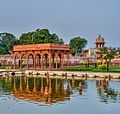Portal:Gardening
The Gardening Portal

Gardening is the process of growing plants for their vegetables, fruits, flowers, herbs, and appearances within a designated space. Gardens fulfill a wide assortment of purposes, notably the production of aesthetically pleasing areas, medicines, cosmetics, dyes, foods, poisons, wildlife habitats, and saleable goods (see market gardening). People often partake in gardening for its therapeutic, health, educational, cultural, philosophical, environmental, and religious benefits. Gardening varies in scale from the 800 hectare Versailles gardens down to container gardens grown inside. Gardens take many forms, some only contain one type of plant while others involve a complex assortment of plants with no particular order. (Full article...)
Horticulture is the science, technology, art, and business of cultivating and using plants to improve human life. Horticulturists and Horticultural Scientists create global solutions for safe, sustainable, nutritious food and healthy, restorative, and beautiful environments. This definition is seen in its etymology, which is derived from the Latin words hortus, which means "garden" and cultura which means "to cultivate". There are various divisions of horticulture because plants are grown for a variety of purposes. These divisions include, but are not limited to: gardening, plant production/propagation, arboriculture, landscaping, floriculture and turf maintenance. For each of these, there are various professions, aspects, tools used and associated challenges; Each requiring highly specialized skills and knowledge of the horticulturist. (Full article...)
General images -
Selected article -
Banksia integrifolia, commonly known as the coast banksia, is a species of tree that grows along the east coast of Australia. One of the most widely distributed Banksia species, it occurs between Victoria and Central Queensland in a broad range of habitats, from coastal dunes to mountains. It is highly variable in form, but is most often encountered as a tree up to 25 metres (82 ft) in height. Its leaves have dark green upper surfaces and white undersides, a contrast that can be striking on windy days.
It is one of the four original Banksia species collected by Sir Joseph Banks in 1770, and one of four species published in 1782 as part of Carolus Linnaeus the Younger's original description of the genus. It has had a complicated taxonomic history, with numerous species and varieties ascribed to it, only to be rejected or promoted to separate species. Modern taxonomy recognises three subspecies: B. integrifolia subsp. integrifolia, B. integrifolia subsp. compar and B. integrifolia subsp. monticola. (Full article...)Selected image
Related portals
Did you know -
- ... that in 2023, a sculpture garden in Praunheim displayed abstract works by Hans Steinbrenner from different periods of his life, and corresponding works by his friends and students?
- ... that Ardwall House has a garden ornament in the form of an early mediaeval Pictish slab inscribed with a Celtic cross?
- ... that Parimal Garden in Ahmedabad has scrap-metal monkeys?
- ... that Nusrati attributes the virtues of a good ruler to his patron Ali Adil Shah II in The Rose Garden of Love?
- ... that Monmouth Coffee Company in Covent Garden was one of the foundations for the third wave of coffee in London?
- ... that Nizza in central Frankfurt is one of the largest gardens of Mediterranean plants north of the Alps, thanks to its very warm microclimate?
- ... that the Shakespeare garden in Wessington Springs, South Dakota, was the first of its kind in the state?
- ... that the New Zealand Geographic Board initially rejected the name of the Garden of Eden Ice Plateau for being biblical in origin?
Things you can do
- This list is transcluded from the tasks list page. To edit the list, click here
 |
Here are some tasks awaiting attention:
|
WikiProjects
Topics
Categories
Associated Wikimedia
The following Wikimedia Foundation sister projects provide more on this subject:
-
Commons
Free media repository -
Wikibooks
Free textbooks and manuals -
Wikidata
Free knowledge base -
Wikinews
Free-content news -
Wikiquote
Collection of quotations -
Wikisource
Free-content library -
Wikiversity
Free learning tools -
Wiktionary
Dictionary and thesaurus
























































































